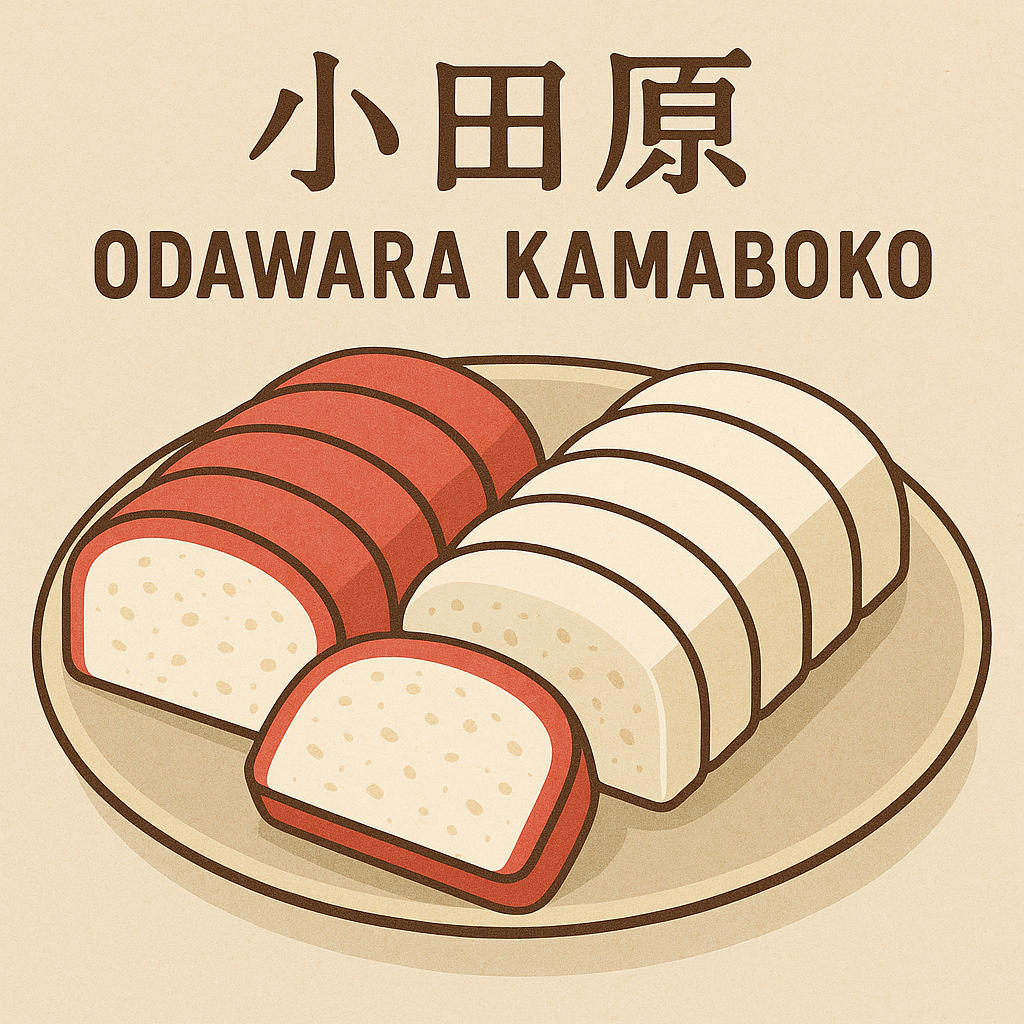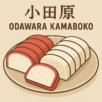
Discovering Odawara Kamaboko: Japan’s Elegant Fish Cake
When most people think of Japanese cuisine, sushi, ramen, or tempura usually come to mind. But tucked away in traditional bento boxes, floating in hearty bowls of oden, or elegantly displayed in local food markets, there’s another uniquely Japanese delicacy waiting to be discovered—kamaboko, a type of steamed fish cake.
If you’ve ever seen a pink-and-white spiral topping on ramen (known as narutomaki), then you’ve had a glimpse of kamaboko. But what many visitors don’t realize is that kamaboko is far more than just a ramen garnish. It is a centuries-old culinary art, deeply rooted in Japanese food culture. And one of the best places to experience authentic kamaboko is in Odawara, a historic castle town in Kanagawa Prefecture.
What Is Kamaboko?
Kamaboko is made from finely ground white fish (such as eso or guchi), which is kneaded into a smooth paste, shaped by hand, and steamed on a wooden board. The result is a beautifully firm, slightly bouncy texture with a clean, subtle flavor. Unlike many fish cakes around the world—often deep-fried or heavily seasoned—kamaboko highlights the delicate umami of fish itself.
In Japan, it’s not just food—it’s craftsmanship. Skilled artisans carefully balance ingredients, texture, and visual beauty, making kamaboko as much a feast for the eyes as it is for the palate.
Kamaboko Around the World: Similar, Yet Different
Fish cakes exist in many cultures: Korean eomuk, Chinese fish balls, Vietnamese chả cá, and even Western-style fish patties. However, these are typically softer, fried, or spiced, often enjoyed as street food or comfort food. Kamaboko, in contrast, is steamed, refined, and designed to complement other elements of a meal with grace.
Its firm texture and mild taste make it a versatile addition to many dishes—enjoyed chilled with wasabi and soy sauce, sliced into soups, or grilled to bring out a subtle sweetness.
Why Odawara Kamaboko?
Odawara has been known for producing premium kamaboko for over 200 years. Its location near Sagami Bay provided abundant fresh fish, and the area’s clean water and skilled artisans helped develop a distinct tradition. Today, Odawara’s kamaboko is prized for its firm texture, natural ingredients, and elegant presentation.
Many shops in Odawara still use time-honored techniques, such as stone-milling the fish paste and steaming on cedar boards. Some even offer hands-on workshops where you can shape and steam your own kamaboko—a memorable, delicious souvenir of your journey in Japan.
Experience Kamaboko During Your Visit
If you’re planning a trip to the Hakone or Mt. Fuji area, a stop in Odawara is both convenient and rewarding. Visit the Odawara Kamaboko Street, explore the Suzunari Kamaboko Museum, or simply enjoy fresh kamaboko at local restaurants.
Whether you’re a curious foodie or a cultural explorer, discovering kamaboko is a way to taste the subtle artistry of Japan—one delicious slice at a time.
Pro tip: Try freshly grilled kamaboko on a stick from a shop in Odawara—it’s warm, smoky, and unforgettable.
小田原蒲鉾を発見する:日本の上品な魚の練り物
多くの人が日本料理と聞いて思い浮かべるのは、寿司、ラーメン、または天ぷらでしょう。しかし、伝統的なお弁当にそっと入っていたり、具だくさんのおでんの中に浮かんでいたり、地元の市場に美しく並べられていたりする、もう一つの日本独自の美味が存在します。それが――蒲鉾(かまぼこ)、蒸した魚のすり身でできた練り物です。
もしもラーメンの上にのったピンクと白の渦巻き模様(なると巻き)を見たことがあれば、蒲鉾の一端をすでに味わっているかもしれません。しかし、多くの訪日旅行者は、蒲鉾が単なるラーメンのトッピング以上の存在であることに気づいていません。蒲鉾は、何世紀にもわたり受け継がれてきた料理の技であり、日本の食文化に深く根付いたものなのです。そして本物の蒲鉾を体験するのに最適な場所の一つが、神奈川県にある歴史ある城下町――小田原です。
蒲鉾とは?
蒲鉾は、白身魚(エソやグチなど)を細かくすりつぶし、なめらかなペースト状に練り上げ、手で成形し、木の板にのせて蒸して作られます。その結果、しっかりとしたコシと弾力のある食感、そして清らかで控えめな味わいが生まれます。世界の多くの魚の練り物が揚げられていたり、濃い味付けがされていたりするのに対し、蒲鉾は魚そのものの繊細なうまみを引き出すように作られています。
日本では、それは単なる食品ではありません――それは職人技なのです。熟練の職人が材料のバランス、食感、そして見た目の美しさまで丁寧に調整し、蒲鉾は目でも舌でも楽しめる芸術作品のような存在になっています。
世界の魚のすり身食品:似ているけれど違う
魚のすり身を使った食品は、世界中の多くの文化に存在します。韓国のオムク、中国の魚団子、ベトナムのチャーカー、そして欧米のフィッシュパティなど。しかし、これらの多くは柔らかく、揚げてあったり、香辛料が効いていたりすることが多く、屋台料理や家庭料理として親しまれています。
それに対して蒲鉾は、蒸されており、上品で、料理の他の要素を引き立てるように繊細に設計されています。
そのしっかりとした歯ごたえと穏やかな味わいは、多くの料理に柔軟に使える特性を持っています――ワサビと醤油で冷やして食べたり、スープにスライスして加えたり、焼いて甘みを引き出したりと、様々な楽しみ方があります。
なぜ小田原蒲鉾なのか?
小田原は、200年以上にわたって上質な蒲鉾を生産してきたことで知られています。相模湾に近い立地は新鮮な魚に恵まれ、この地域の清らかな水と熟練の職人たちによって、独自の伝統が育まれてきました。今日でも、小田原の蒲鉾はしっかりとした食感、自然な素材、美しい見た目で高く評価されています。
多くの小田原の店舗では、今でも石臼で魚のすり身を練り、杉板の上で蒸すといった昔ながらの製法を守っています。中には、自分で蒲鉾を成形して蒸すことができる体験型の工房もあり、日本での思い出に残る、美味しいお土産づくりが楽しめます。
日本滞在中に蒲鉾を体験しよう
もし箱根や富士山方面への旅行を予定しているなら、小田原に立ち寄るのは便利でありながら、とても価値のある体験です。小田原かまぼこ通りを歩いてみたり、鈴廣かまぼこ博物館を訪ねたり、地元の飲食店で新鮮な蒲鉾を味わったりできます。
好奇心旺盛なフーディー(美食家)であれ、文化を探求する旅行者であれ、蒲鉾を味わうことは、日本の繊細な職人芸を舌で感じる旅になるでしょう――一切れ一切れが、そんな体験を与えてくれます。
旅の豆知識: 小田原の店舗で売られている、焼きたての蒲鉾を串に刺したものをぜひ試してみてください――温かく、香ばしく、忘れられない味です。
- Iriomote Island Mangrove Forest – A Pristine Scenic Spot in Southern Japan
- Sapporo White Illumination – Where Snow and Light Define Winter in Japan
- Kue Nabe: Wakayama’s Legendary Winter Hot Pot
- Nabana no Sato Illumination – A Grand Light Spectacle of Japan’s Winter
- Kobe Luminarie – A Festival of Light, Memory, and Hope
